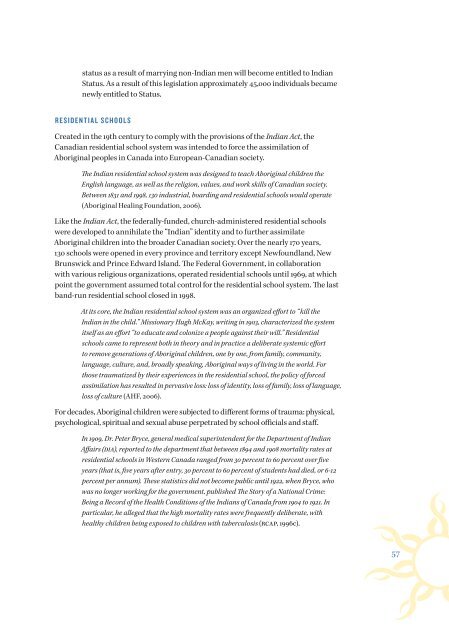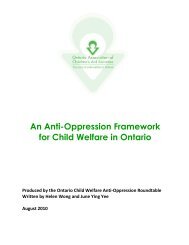English - Ontario Association of Children's Aid Societies
English - Ontario Association of Children's Aid Societies
English - Ontario Association of Children's Aid Societies
Create successful ePaper yourself
Turn your PDF publications into a flip-book with our unique Google optimized e-Paper software.
status as a result <strong>of</strong> marrying non-Indian men will become entitled to Indian<br />
Status. As a result <strong>of</strong> this legislation approximately 45,000 individuals became<br />
newly entitled to Status.<br />
RESIDENTIAL SCHOOLS<br />
Created in the 19th century to comply with the provisions <strong>of</strong> the Indian Act, the<br />
Canadian residential school system was intended to force the assimilation <strong>of</strong><br />
Aboriginal peoples in Canada into European-Canadian society.<br />
The Indian residential school system was designed to teach Aboriginal children the<br />
<strong>English</strong> language, as well as the religion, values, and work skills <strong>of</strong> Canadian society.<br />
Between 1831 and 1998, 130 industrial, boarding and residential schools would operate<br />
(Aboriginal Healing Foundation, 2006).<br />
Like the Indian Act, the federally-funded, church-administered residential schools<br />
were developed to annihilate the “Indian” identity and to further assimilate<br />
Aboriginal children into the broader Canadian society. Over the nearly 170 years,<br />
130 schools were opened in every province and territory except Newfoundland, New<br />
Brunswick and Prince Edward Island. The Federal Government, in collaboration<br />
with various religious organizations, operated residential schools until 1969, at which<br />
point the government assumed total control for the residential school system. The last<br />
band-run residential school closed in 1998.<br />
At its core, the Indian residential school system was an organized effort to “ kill the<br />
Indian in the child.” Missionary Hugh McKay, writing in 1903, characterized the system<br />
itself as an effort “to educate and colonize a people against their will.” Residential<br />
schools came to represent both in theory and in practice a deliberate systemic effort<br />
to remove generations <strong>of</strong> Aboriginal children, one by one, from family, community,<br />
language, culture, and, broadly speaking, Aboriginal ways <strong>of</strong> living in the world. For<br />
those traumatized by their experiences in the residential school, the policy <strong>of</strong> forced<br />
assimilation has resulted in pervasive loss: loss <strong>of</strong> identity, loss <strong>of</strong> family, loss <strong>of</strong> language,<br />
loss <strong>of</strong> culture (AHF, 2006).<br />
For decades, Aboriginal children were subjected to different forms <strong>of</strong> trauma: physical,<br />
psychological, spiritual and sexual abuse perpetrated by school <strong>of</strong>ficials and staff.<br />
In 1909, Dr. Peter Bryce, general medical superintendent for the Department <strong>of</strong> Indian<br />
Affairs (DIA), reported to the department that between 1894 and 1908 mortality rates at<br />
residential schools in Western Canada ranged from 30 percent to 60 percent over five<br />
years (that is, five years after entry, 30 percent to 60 percent <strong>of</strong> students had died, or 6-12<br />
percent per annum). These statistics did not become public until 1922, when Bryce, who<br />
was no longer working for the government, published The Story <strong>of</strong> a National Crime:<br />
Being a Record <strong>of</strong> the Health Conditions <strong>of</strong> the Indians <strong>of</strong> Canada from 1904 to 1921. In<br />
particular, he alleged that the high mortality rates were frequently deliberate, with<br />
healthy children being exposed to children with tuberculosis (RCAP, 1996c).<br />
57

















